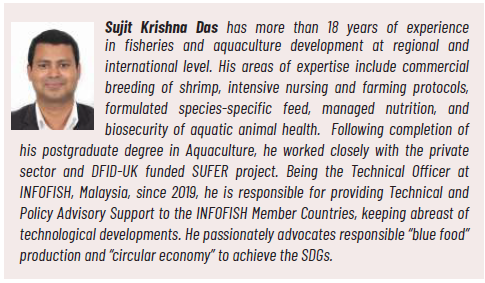Article II 4/2024: DRIED FISH INDUSTRY IN BANGLADESH: ISSUES AND CONCERNS
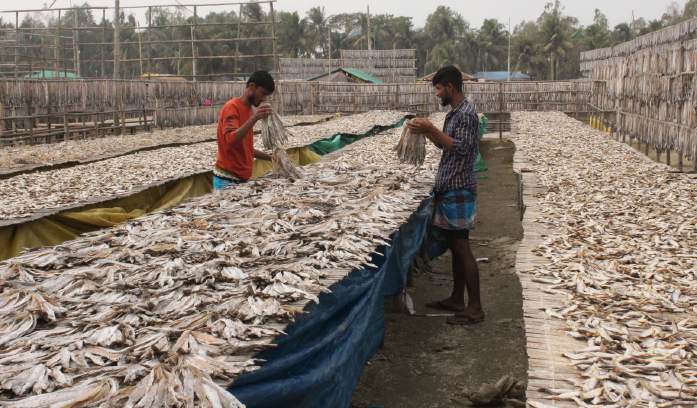
The role of fisheries and aquaculture in the national economy, food security and nutrition of Bangladesh is enormous. The sector contributes 2.43% to the GDP, 22.14% to the agricultural GDP and 1.05% to the total national exports; some 5.74% of the GDP growth was achieved from the fisheries sub-sector (Bangladesh Economic Review 2023)1. Per capita fish consumption has increased from 60 g/day to 67.80 g/day (Household Income and Expenditure Survey 2022)2 and around 12% of the total population (19.5 million) of the country is directly or indirectly dependent upon the fisheries sector, of whom 1.4 million are women (Department of Fisheries, DoF 2023)3.
Bangladesh has achieved tremendous progress in the fisheries sector due to the adoption of agriculturally-friendly policies and strategies at national and local level by the government. The Ministry of Fisheries and Livestock (MoFL) is working to build a sustainable, safe, and profitable agricultural system to ensure food security in light of Vision 2041, the 8th Five Year Plan, National Agricultural Policy 2018, the UN Sustainable Development Goals (SDGs), Deltaplan-2100 and other policy documents. As a result, the country has become self-reliant in aquaculture production since the 2016–17 Fiscal Year (FY), for the first time since the country’s independence.
In FY 2021–22, total fish production was recorded as 4.75 million tonnes whereas it was 3.06 million tonnes during 2010–11 FY, representing a growth of 55.42% over the last decade. The country’s achievement in the fisheries sector has also been recognised internationally. According to SOFIA 2022 (State of World Fisheries and Aquaculture published by the UN FAO), Bangladesh ranked 3rd globally in inland freshwater capture fish production and 5th in inland closed water fish production in 2020. Moreover, the country took 8th and 12th position respectively for crustacean and marine fish production under the marine and coastal aquaculture category. Bangladesh also leads in hilsa shad production among the 11 hilsa producing countries in the world, and ranks 4th in tilapia production globally (DoF 2023)4.
1) Bangladesh Economic Review 2023 (BER 2023).
2) Household Income and Expenditure Survey 2022 (BIES 2022).
3&4) DoF 2023. National Fish Week 2023 Compendium (in Bengali). Department of Fisheries (DoF), Ministry of Fisheries and Livestock, Bangladesh. 160p.
Dried fish (locally known as shutki) comprise one of the traditional delicacies in Bengali cuisine due to its mouth-watering taste and high nutritional value, as well as being readily available in the market. It plays a vital role as a low-cost, high protein source of food; as an income-generating activity for women; and in contributing to the food value chains by reducing fish loss and waste. In Bangladesh, significant amounts of marine and freshwater fishes are being processed through the traditional sun-drying method.
Dried fishes are rich in high nutritional content and are of great food value. About 2–5 kg of fresh fish is required to make one kg of dried fish; hence the nutritional content per kg is always 2–3 times higher than the raw fish. Thus, dried fish has become a preferred source of high-quality protein for most consumers. In the countryside, especially in the hill tracts and remote areas, dried fish is still considered as one of the key sources of high-quality protein for pregnant women and people recovering from illness. People from different regions like different forms of dried fish e.g. nga-pi (roasted small shrimp paste) is widely consumed by the tribal communities in Rangamati, Khagrachhori and Bandarbans. Shidol and chepa (fermented freshwater barb and marine hairfin anchovy) are also extensively consumed in the Mymensingh, Kishoreganj, Sylhet and Natore areas. Roasted Bombay duck, large head-hairtail or small shrimp (loittya, chhuri and icha shutki) paste mixed with chopped onion, green/roasted chili, salt, mustard oil and green coriander leaves comprise the traditional recipe in the Chittagong and Cox’s Bazar areas.
Dried fish has a rich amino acid profile, and is low in cholesterol and saturated fatty acids. It is also full of vitamins (B1, B2, B12 and Vit A) and minerals (calcium, iron, iodine, phosphorus, zinc, copper and antioxidants). The omega-3 (ω3) fatty acids in dry fish play a vital role by reducing the risks of heart diseases and obesity and enhancing the intellectual development of children, as well as increasing metabolic activity and immunity. Thus, dried fish is not only important for its nutritional value but also as part of Bengali culinary tradition and heritage.
However, the scale and significance of dried fish production, trade and consumption is rarely acknowledged and poorly understood, in part because of a tendency for fisheries research to focus on fishers, thereby overlooking actors and processes in mid- and downstream value chain segments (Belton et al., 2017)5. This article addresses the key challenges and issues in the industry, including some specific recommendations to enable market access and formulate national policy for the sustainable development of the industry.
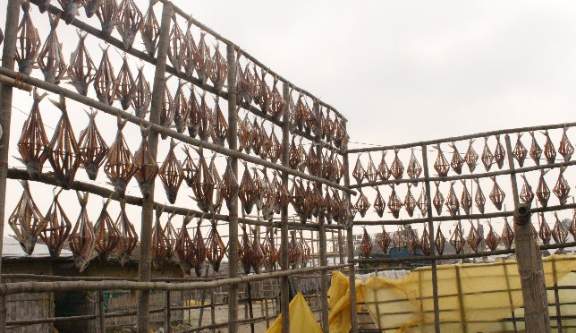

Major producing areas
The large-scale fish drying, and fermentation activities are concentrated in the Chittagong and Cox’s Bazar areas; as well as the Sylhet-Mymensingh- Comilla and Khulna-Barisal-Patuakhali regions. Dublar Char (The Island of Dubla) in the Sundarbans (the largest mangrove forest in the world and a UNESCO heritage site), Khulna, Nazirar Tek and Sonadia in Cox’s Bazar are the largest marine fish drying facilities in the country. Freshwater fishes are mainly dried in the Sylhet-Mymensingh-Comilla region; smaller quantities are dried in the Chalan Beel area in north-central Bangladesh, in Faridpur and Kaptai Lake (Hossain et al. 2015)7.
6) Belton et al., 2022. Dried fish at the intersection of food science, economy, and culture: A global survey. Online Library (Willey) Fish and Fisheries: 942-962.
7) Hossain et al., 2015. Dried fish value chain in Bangladesh. World Fish, Bangladesh and South Asia Office, Dhaka, Bangladesh. 122 p.
Major marine water fish species use for drying
Last year, the author visited Nazirar Tek, Cox’s Bazar, the prime marine dried fish production facility in Bangladesh, also known as the “dried fish processing capital” (shutki palli), to look at production value chains and market potential. Some 26-27 types of marine fish were recorded (Table 1), most of which are commercially important. These fish are being dried and processed, targeting both domestic and export markets. Fish drying activities continue round the year; however, the peak season is mainly August to April, focusing on the winter season.
Drying methods and distribution channel
The raw fish received by the dried fish yards are generally washed, sorted, degutted and salted (especially for high-value fishes like hilsa shad) before going for traditional sun-drying on vertical and horizontal bamboo racks. After two to three days in the sun, the dried fish are stored before packing. The drying process depends on the size of the fish, available sunshine and weather conditions. The packed dried fish are ready for human consumption and distributed to the wholesalers and retailers. The price of the dried fish varies with the species, size, taste and moisture content of the fish. In addition, certain low-value species, spoiled fish, discarded offal, viscera and others are stored to produce fish meal.
Major freshwater fish species used for drying
During the winter season when most of the open water bodies (ponds, flood plains, oxbow lakes, and seasonally-cultured water bodies, etc.) become dry and fish are harvested in bountiful amounts, the villagers preserve them by sun-drying to be used as a source of protein for harder times (rainy season). Small-scale entrepreneurs also sun-dry several freshwater fish species, mostly for domestic trade and local consumption, as well as for export to countries with Bangladeshi diaspora. The freshwater fish drying season generally lies between September to March, varying with the location. The list of the major freshwater fish species used for drying is provided here.
Methods used for freshwater fishes
The drying technique for freshwater fish is sometimes different from the marine species. The head, viscera, gut and air bladder of big fish are removed; the fish is washed and sometimes salted and seasoned with turmeric powder; rewashed, and then sun-dried for 2–3 days on bamboo mats. Smaller fish, especially freshwater barb (punti), are processed by fermentation. Except for some species, the dried freshwater fish mainly go to local markets. Their price varies with the species, size and quality. Usually there are a small number of discards which are used to produce fishmeal.
Issues and concerns associated with the industry
Although dried fish has become a vital source of food and nutrition, and it contributes to the national economy, it has been criticised for pesticide contamination. Sometimes pesticides are utilised in the drying and storage process, especially during the rainy season to prevent the outbreak and growth of flies, maggots and other insects. Thus, it might create adverse health implications for consumers who eat dried fish for a sustained period of time.
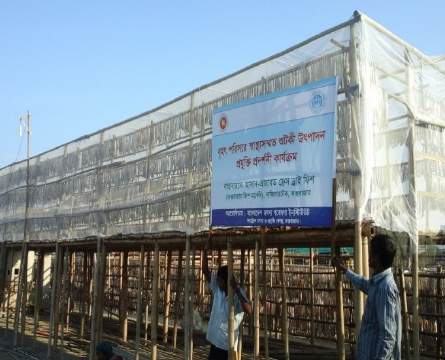
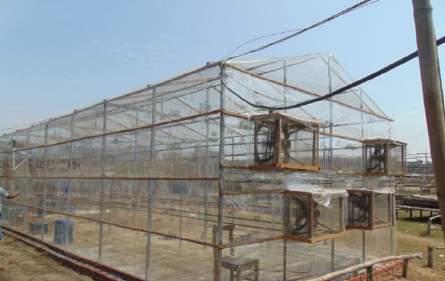
Trade and markets for dried fish
According to the Bangladesh Fisheries Statistics Yearbook (2021–22), in that financial year, the country exported 3 301.54 tonnes of dried fish worth USD 4.4 million (4 691.47 tonnes worth USD 5.7 million in FY 2020- 21; 1 USD = BDT 117.36) (Graph 1)8. The major export destinations for dried marine fish were the Middle East, Pakistan, the United States, the United Kingdom, China, Hong Kong, Vietnam, Malaysia and Sri Lanka. In 2023, Bangladesh produced 0.71 million tonnes of dried fish (about 15 % of the total fish production of 4.76 million tonnes), comprising 85% marine and 15% freshwater.
The domestic market for marine dried fish is mainly positioned in Chittagong, Cox’s Bazar, Patuakhali, Barisal and Khulna Sundarbans whereas the freshwater dried fish market is primarily located in Mymensingh, Kishoreganj, Comilla, Sylhet, Natore, Syedpur and Dhaka. Major products derived from marine fishes are: dried fish, salted fish (hilsa shad), fermented fish (phaisa), nga-pi (roasted small shrimp paste), fish meal, fish oil, by-products (head, viscera, gut, tail, spine, etc.) and others like fish maws and fish scales. Similarly, dried fish, fermented fish (shidol, chepa), fish meal, fish oil and other by-products and co-products are the major freshwater fish products. The dried fish value chain comprises a complex combination of multiple intermediaries which starts with the (i) fish boat owners/fresh fish collectors/fishermen; followed by (ii) dried fish processors; (iii) transporters; and (iv) wholesalers/distributors; (v) retailers; and (vi) consumers.
8) Yearbook of Fisheries Statistics of Bangladesh, 2021-2022, Department of Fisheries, Ministry of Fisheries and Livestock, Bangladesh. 79 p.
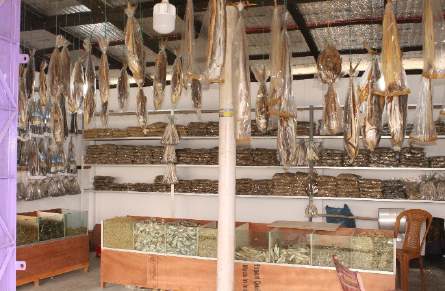
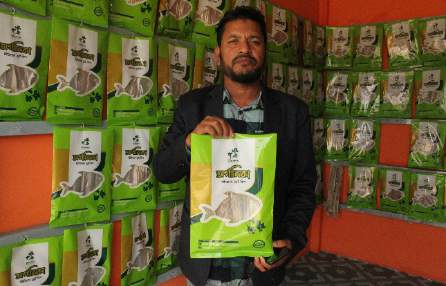
Income generating activity for women
Women participation along the dried fish value chain is highly significant as something like 50% of the workers in the fish drying yards are women. Their operation starts with the sorting and washing of fish when the fresh harvest arrives at the coast or fish landing centre. The fish are transported to a drying yard where the women work together with men in sorting and then placing them onto different horizontal and vertical bamboo structures for the next two to three days. The dried fish are packed and transported to a depot from where they are sent to different domestic and international trade destinations. The finished products are available at dried fish shops and supermarkets, where they may be packed and branded as organic dried fish.
Most women work part-time in the fish drying yard to generate income for their families. However it should be noted that the environmental features in the fish drying yard like the waste management system, water and sanitation system, and health and occupational safety, are usually inadequate. The overall wellbeing of the women workers is yet to be addressed.
Labour issues and well being
Although men and women have clear segregation of work, both are casual laborers in the fish drying yards. While the women sort the fish, the men transport them from the boat to the yard, unloading and loading the raw and dried fishes to and from the truck. Labour demand climbs high during the peak season. Most of the labourers in the Cox’s Bazar region are Rohingyas (refugees from Myanmar) and seasonal workers from different parts of the country.
As most of the labourers are contractual, their working hours vary (6 a.m.–6 p.m.), salaries differ, recruiters neither maintain a leave policy, nor the workers have access to medical assistance or recreational facilities. They do not maintain practices linked to Standard Operating Procedure (SOP) such as washing hands with soap and clean water, wearing aprons, hand gloves, face masks, gum boots and other security measures to avoid any contamination.
Conclusions and recommendations
The following specific recommendations are part of a strategic plan which may be useful in developing the “Small in scale, Big in nutrition” dried fish industry of Bangladesh:
• A long-term, inclusive and gender-focused development approach should be taken to improve the dried fish industry in Bangladesh;
• The Ministry of Fisheries and Livestock (MoFL) should assess the supply and demand, market prospects, food safety and public health issues to exploit the maximum benefit from this industry;
• The Ministry of Commerce (MoC) should declare a special ‘Export Processing Zone’ to ensure the supply of safe and hygienic dried fish products by enabling appropriate infrastructure and facilitating market access;
• Advanced (solar and mechanical) fish drying methods should be introduced to reduce fish loss and waste and to ensure public health and safety;
• Application of unauthorised chemicals and pesticides along the dried fish value chains should be monitored closely by the Fish Inspection and Quality Control Division (FIQC) of the Department of Fisheries (DoF); and
• Financial institutions should facilitate interest-free loans for dried fish processors to ensure the sustainability of this small-scale fisheries sector.
